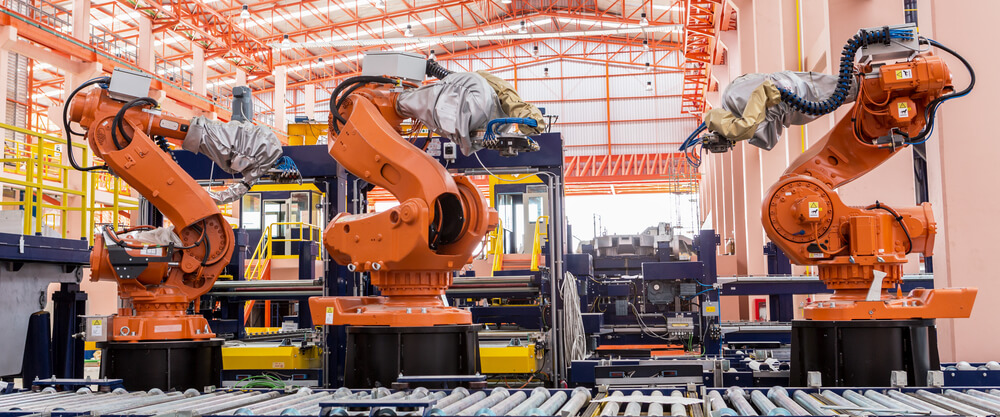
The Internet of Things is enabling manufacturers to become smarter. Source: Shutterstock
Can IoT transform your manufacturing business?
THE Internet of Things (IoT) revolution is impacting the way many companies around the world are doing business.
It’s enabling businesses to become smarter, achieving better outcomes than ever before.
A prime example of where IoT is making a large business impact is in the industrial field. As we propel into Industry 4.0, many manufacturers are realizing the need to digitize in order to stay competitive.
With the help of IoT sensors, manufacturers are now able to gather a large amount of valuable data.
Using machine learning and artificial intelligence, analysis of this data can be made in order to garner insights that can increase efficiencies, streamline their operations, and identify new business opportunities.
Despite its advantages, not everyone has a clear notion of how IoT can accelerate the manufacturing industry.
According to a report by AT&T Business, a mere 4 percent of medium-sized manufacturers claim to have an “excellent” understanding of smart IoT solutions. And only 22 percent have actually deployed IoT devices.
While IoT knowledge appears to be in its infancy, the trend in manufacturing is unlikely to change anytime soon.
According to research firm BI Intelligence, the number of connected machines in the manufacturing industry is expected to increase from 237 million in 2015, to 923 million in 2020.
So, with IoT solutions in manufacturing only to expected to skyrocket, here are three ways it will impact the industry.
1.Operational efficiency
Those manufacturing companies who are still using traditional methods in supply chain management are majorly lacking transparency.
Within manufacturing environments, IoT connects assets to processes, systems, and people. This enables the sharing of data across the whole supply chain, meaning that everyone gets a clearer, greater understanding of the process.

IoT enables greater transparency. Source: Shutterstock
With greater visibility, companies are able to optimize their operations and be fully prepared for future demand, resulting in a more productive workforce.
Here are two examples of how IoT boosts efficiency:
Inventory management: By equipping smart shelves, forklifts, and other equipment with sensors and wireless communication, manufacturers are able to obtain a real-time view of inventory.
Workforce management: Through the collection of data from machines, assets, and computers, companies are able to track the productivity of their employees.
Managers will no longer have to walk the factory floor. Instead, they can view real-time productivity levels on a dashboard. This data will enable managers to make smart decisions about how they can help their employees perform better.
2. Production asset management and maintenance
Another use case of IoT in manufacturing is its ability to monitor and track production assets in areas such as quality, performance, the potential for damage or breakdowns, bottlenecks, and more.
According to an article by TechRepublic, a company called Tata Power in India were able to save nearly US$300,000 after employees received an early warning about a problem with a gas turbine.
The gas turbine was able to immediately report information regarding its problem, enabling maintenance to be carried as soon as possible. If this wasn’t the case, the problem could have spiraled into something much less controllable.
The ability to receive early warnings such as this would not be possible without the monitoring of real-time data gathered from IoT devices.

Companies can detect potential equipment issues. Source: Shutterstock
Today, IoT sensors and data analytics enable manufacturers to detect even the smallest of errors in the production process.
This is application of IoT is extremely valuable for the manufacturing industry, who previously would have to discard equipment and products where issues had arisen. Now manufacturers can mitigate big problems before they happen, saving both time and money.
3. The improved safety of workers
The Internet of Things (IoT) is truly revolutionizing safety management for companies worldwide, including those in the manufacturing industry.
Saftey is a top concern in manufacturing, and businesses are always looking for ways to improve their protection of the workforce.
Firstly, the safety of employees can be enhanced through the use of sensors in detecting malfunctioning systems. This will prevent the likelihood of employee injuries by bringing a potential danger to their attention before it becomes a threat.

IoT technology enables the working environment to be safer. Source: Shutterstock
Secondly, many companies are fitting their employees with wearable devices that can track and monitor their health and safety.
One Australian construction company has provided its employees who work in the outback with smart helmets which are equipped with sensors.
These sensors monitor each employee’s temperature, heart rate, humidity, and more in order to help them avoid heatstroke- a common but dangerous occurrence in Australia.
All the IoT data from the sensors are then uploaded to the Cloud, where Microsoft Azure and Microsoft Power Bi organize and analyze it.




